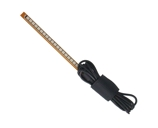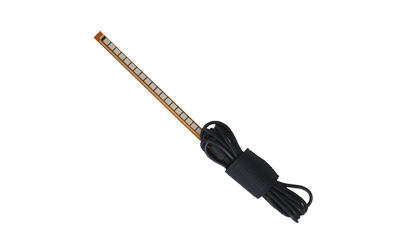Product Overview
 The Bend sensor is a small enough sensor to be placed on fingers and wrists to monitor joint motion 180 degrees of flexion. Use sensors back to back to get a 360 degree range.
The Bend sensor is a small enough sensor to be placed on fingers and wrists to monitor joint motion 180 degrees of flexion. Use sensors back to back to get a 360 degree range.
Technical Specifications
- Length : ~152cm (60”)
- Weight : ~10g
- Bend Sensor Type : Variable resistive
- Sensor Resistive Range : 5KΩ – 400KΩ (native Infiniti modes)
- Output Voltage Transfer Function : Vout = [RBs +243KΩ/(RBs +992KΩ)] * Vs where RBs =
Resistance of Bend sensor in KΩand Vs = Sensor supply voltage
- Current Consumption : < 1mA @ 7.26V nominal
- Supply Voltage : 7.26VDC
- Resistance to Voltage Accuracy : ± 1%
This sensor provides good relative measurements of flexion or extension when securely fastened to the subject. The output voltage signal may be converted to degrees for demonstration purposes. However due to the nature of the sensor it cannot be used for absolute angle measurements.
Interfacing with 3rd Party Data Acquisition Systems
Recommended Connectivity for Electrical Safety
Thought Technology recommends the use of TT Sensor Isolator ST9405AM when interfacing patient connected sensor(s) to line powered equipment(s) or devices.
 The TT Sensor Isolator ST9405AM is an interface device providing medical grade electrical isolation between the patient connected sensors and the acquisition system. It provides the equivalent of Two Means of Patient Protection under IEC 60601-1, and supplies battery power to the sensors. Using this device ensures Thought Technology sensors are safely interfaced to the analog inputs of line-powered systems such as computers with DAQ cards.
The TT Sensor Isolator ST9405AM is an interface device providing medical grade electrical isolation between the patient connected sensors and the acquisition system. It provides the equivalent of Two Means of Patient Protection under IEC 60601-1, and supplies battery power to the sensors. Using this device ensures Thought Technology sensors are safely interfaced to the analog inputs of line-powered systems such as computers with DAQ cards.
Note that this device isolates only between sensors and the DAQ interface, not between different sensor channels.
The TT Sensor Isolator can interface up to 4 sensors to a DAQ card. TT Sensor Isolator can be connected to the DAQ card in two ways:
- via two stereo jacks, or
- via a DB-15 connector; a BNC interface cable (SA9409BNC) or a pigtail cable (SA9409PGT) can be provided with the unit.

For more detailed information on the Sensor Isolator 4∞, consult the Thought Technology Science Division website or contact the sales department or your distributor.
Division website or contact the sales department or your distributor.
Direct Connectivity for Electrically Isolated Systems
The following notes are provided for qualified users to directly interface Thought Technology sensors with external systems.
WARNING: If the sensor is interfaced to non-Thought Technology devices without the use of a TT Sensor Isolator SE9405AM, an elevated risk of electrical shock may be present. In particular, if a patient-connected sensor is connected to any line powered device(s) or equipment(s), it will be the responsibility of the qualified user to ensure the electrical safety in the setup and to ensure that the device or equipment provides sufficient isolation.
To interface with a sensor, a single sensor cable may be cut in half. Both sides can then be used to make custom interfacing cables by stripping the outer insulation of each required conductor. The sensor cable contains 4 color coded conductors. The table below shows the color coding and pin connector assignment.
| Pin |
Color Code |
Function |
Note |
| 1 |
metal (shield) |
ground |
Signal and power ground, connection required. |
| 2 |
yellow |
auxiliary (sensor ID) |
No connection required. |
| 3 |
green |
signal |
Sensor output signal |
| 4 |
red |
sensor power |
Supply voltage, +7.26V referenced to ground. Note: sensor performance may be sensitive to supply voltage. |

Notes:
1. The nominal supply voltage for this sensor is 7.26V. The sensor can safely be used with a supply voltage of up to 9V. However, as the sensor is calibrated with a 7.26V supply voltage level, changes in gain and offset may be expected when operating at a different supply voltage level, changes in gain and offset may be expected when operating at a different supply voltage.
Recommended Specifications for DAQ Hardware
- Recommended resolution of 0.15mV (16-bit ADC over 10V span) or better
- Minimum input range:
- If connected via SE9405AM Sensor Isolator, choose 0-5V (unipolar) or ±5V (bipolar).
- If directly connected to DAQ, choose ±5V (bipolar).
Simplified Transfer Function
 Conversion of voltage [V] to output angle in degrees.
Conversion of voltage [V] to output angle in degrees.
Product Overview
 The Bend sensor is a small enough sensor to be placed on fingers and wrists to monitor joint motion 180 degrees of flexion. Use sensors back to back to get a 360 degree range.
The Bend sensor is a small enough sensor to be placed on fingers and wrists to monitor joint motion 180 degrees of flexion. Use sensors back to back to get a 360 degree range.
Technical Specifications
- Length : ~152cm (60”)
- Weight : ~10g
- Bend Sensor Type : Variable resistive
- Sensor Resistive Range : 5KΩ – 400KΩ (native Infiniti modes)
- Output Voltage Transfer Function : Vout = [RBs +243KΩ/(RBs +992KΩ)] * Vs where RBs =
Resistance of Bend sensor in KΩand Vs = Sensor supply voltage
- Current Consumption : < 1mA @ 7.26V nominal
- Supply Voltage : 7.26VDC
- Resistance to Voltage Accuracy : ± 1%
This sensor provides good relative measurements of flexion or extension when securely fastened to the subject. The output voltage signal may be converted to degrees for demonstration purposes. However due to the nature of the sensor it cannot be used for absolute angle measurements.
Interfacing with 3rd Party Data Acquisition Systems
Recommended Connectivity for Electrical Safety
Thought Technology recommends the use of TT Sensor Isolator ST9405AM when interfacing patient connected sensor(s) to line powered equipment(s) or devices.
 The TT Sensor Isolator ST9405AM is an interface device providing medical grade electrical isolation between the patient connected sensors and the acquisition system. It provides the equivalent of Two Means of Patient Protection under IEC 60601-1, and supplies battery power to the sensors. Using this device ensures Thought Technology sensors are safely interfaced to the analog inputs of line-powered systems such as computers with DAQ cards.
The TT Sensor Isolator ST9405AM is an interface device providing medical grade electrical isolation between the patient connected sensors and the acquisition system. It provides the equivalent of Two Means of Patient Protection under IEC 60601-1, and supplies battery power to the sensors. Using this device ensures Thought Technology sensors are safely interfaced to the analog inputs of line-powered systems such as computers with DAQ cards.
Note that this device isolates only between sensors and the DAQ interface, not between different sensor channels.
The TT Sensor Isolator can interface up to 4 sensors to a DAQ card. TT Sensor Isolator can be connected to the DAQ card in two ways:
- via two stereo jacks, or
- via a DB-15 connector; a BNC interface cable (SA9409BNC) or a pigtail cable (SA9409PGT) can be provided with the unit.

For more detailed information on the Sensor Isolator 4∞, consult the Thought Technology Science Division website or contact the sales department or your distributor.
Division website or contact the sales department or your distributor.
Direct Connectivity for Electrically Isolated Systems
The following notes are provided for qualified users to directly interface Thought Technology sensors with external systems.
WARNING: If the sensor is interfaced to non-Thought Technology devices without the use of a TT Sensor Isolator SE9405AM, an elevated risk of electrical shock may be present. In particular, if a patient-connected sensor is connected to any line powered device(s) or equipment(s), it will be the responsibility of the qualified user to ensure the electrical safety in the setup and to ensure that the device or equipment provides sufficient isolation.
To interface with a sensor, a single sensor cable may be cut in half. Both sides can then be used to make custom interfacing cables by stripping the outer insulation of each required conductor. The sensor cable contains 4 color coded conductors. The table below shows the color coding and pin connector assignment.
| Pin |
Color Code |
Function |
Note |
| 1 |
metal (shield) |
ground |
Signal and power ground, connection required. |
| 2 |
yellow |
auxiliary (sensor ID) |
No connection required. |
| 3 |
green |
signal |
Sensor output signal |
| 4 |
red |
sensor power |
Supply voltage, +7.26V referenced to ground. Note: sensor performance may be sensitive to supply voltage. |

Notes:
1. The nominal supply voltage for this sensor is 7.26V. The sensor can safely be used with a supply voltage of up to 9V. However, as the sensor is calibrated with a 7.26V supply voltage level, changes in gain and offset may be expected when operating at a different supply voltage level, changes in gain and offset may be expected when operating at a different supply voltage.
Recommended Specifications for DAQ Hardware
- Recommended resolution of 0.15mV (16-bit ADC over 10V span) or better
- Minimum input range:
- If connected via SE9405AM Sensor Isolator, choose 0-5V (unipolar) or ±5V (bipolar).
- If directly connected to DAQ, choose ±5V (bipolar).
Simplified Transfer Function
 Conversion of voltage [V] to output angle in degrees.
Conversion of voltage [V] to output angle in degrees.

 The Bend sensor is a small enough sensor to be placed on fingers and wrists to monitor joint motion 180 degrees of flexion. Use sensors back to back to get a 360 degree range.
The Bend sensor is a small enough sensor to be placed on fingers and wrists to monitor joint motion 180 degrees of flexion. Use sensors back to back to get a 360 degree range. 

 TT Infra Sensor
TT Infra Sensor